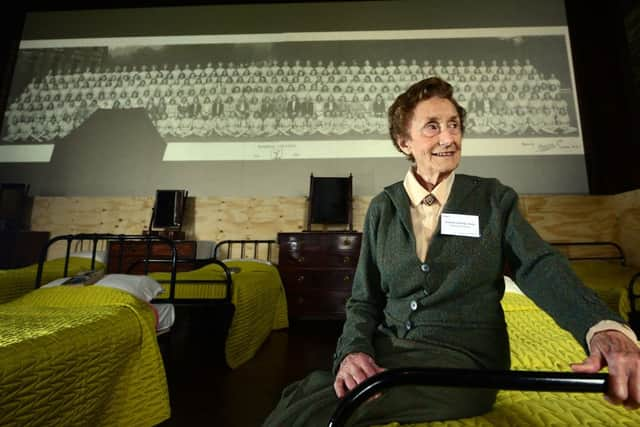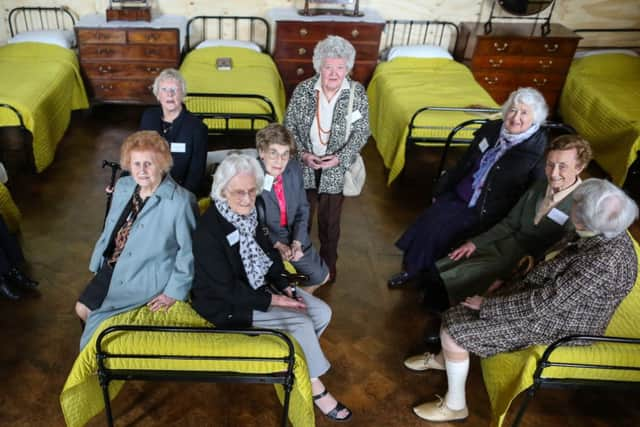Video: Emotional return for Chatsworth’s wartime refugee girls


For the schoolgirls of Penhros College it was the home which shielded them from the horrors of war-torn Britain for seven long years.
Through its long history, the state drawing room at Chatsworth House, Derbyshire had been reserved for guests with only the bluest of blood.
Advertisement
Hide AdAdvertisement
Hide AdBut all that changed in 1939, when boarders from Colwyn Bay were transported to the estate after the Government took over their school.


And it made for poignant scenes when 48 former pupils made a return to the dormitory – dressed as it would have been when the 10th Duke of Devonshire opened his home to the girls – to mark the launch of a new exhibition.
“It is emotional,” said Ann Delves, aged 80, “Chatsworth has always had a special place in my heart, it still does more than 70 years later.”
The event saw Lady Elizabeth Cavendish, daughter of the 10th Duke, reunited with some of the schoolgirls she joined for lessons during their time at Chatsworth.
Advertisement
Hide AdAdvertisement
Hide AdSome of the stories of pyjama parties on rooftops and mischief-making in the grounds echoed the pages of a St Trinian’s caper.


But these ordinary girls were always aware they were in the most extraordinary of settings. So much so that one woman recalled how a mere ink spillage in an English class made it in to the house’s historical records.
“I slept between Henry VIII’s feet, at the foot of a portrait in the yellow drawing room,” added Ann.
The sense grandeur and an awareness of the rich heritage of the house was never lost on pupils like Nancie Park, who came to Chatsworth homesick and frightened aged 11.
Advertisement
Hide AdAdvertisement
Hide AdNancie, aged 85, who now lives in the nearby village of Edensor, said: “I just remember being filled with awe at the place. I still feel it now I’ve been back to Chatsworth.
“This is almost identical to the room I slept in – though the mattresses were a bit harder.”
Pupils’ legs were often tired from trailing the grounds of the vast estate to make it to lessons each day.
Art was taught in the orangery, but the risk of unplanned explosions meant chemistry lessons were kept out of the main house.
Advertisement
Hide AdAdvertisement
Hide AdArchive footage and images of staff and pupils’ sports days in the grounds and ice skating on the Canal Pond formed the backdrop to the old-fashioned books and furnishings of the replica room.
It was not all fun and frolics, however. Rations were served in the rooms which had hosted great feasts and banquets and fuel shortages meant visits from family were rare.
Winters in the 175-room house were exceptionally harsh – as illustrated with the thick woollen undergarments which formed part of the old uniform on display in the new gallery.
Nancie said: “I missed my family. It was very cold during the winter. We had to wear dressing gowns to bed and do what we could to keep warm.
Advertisement
Hide AdAdvertisement
Hide Ad“But it was the war, there was no use complaining, you just got on with it because you had to.”
The story of Penhros is just one of the fascinating chapters of the estate’s history which has been explored by curator Hannah Obee for the Chatsworth in Wartime exhibition, which launches today.
She said: “The headteacher of Penhros was looking for somewhere, she had been warned a year before that the Government would move in if war broke out but she wasn’t able to say anything at first.
“The Duke was keen to offer Chatsworth for the war effort, but a school was a more preferable option than the army moving in, so the arrangement suited them both perfectly.
“It’s such an amazing story and it is such a pleasure to have the ladies of Penhros here with us.”